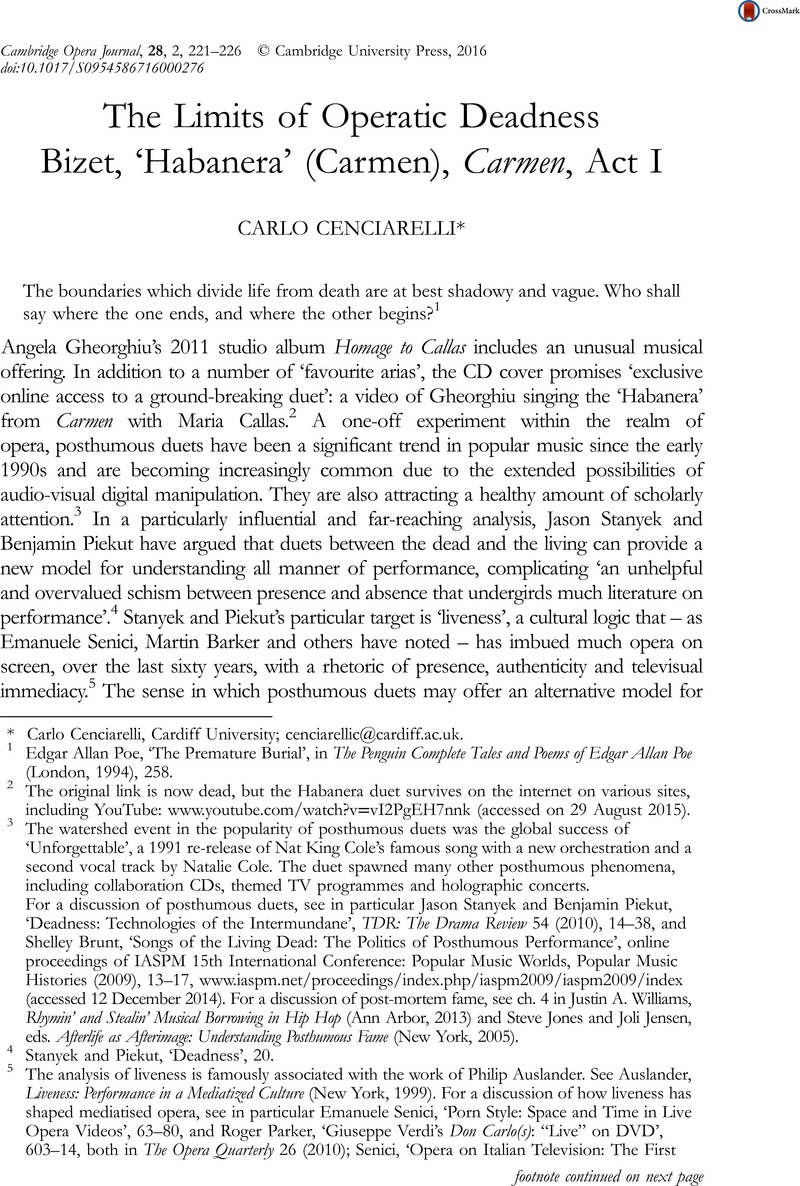Published online by Cambridge University Press: 28 September 2016

Carlo Cenciarelli, Cardiff University; [email protected].
1 Poe, Edgar Allan, ‘The Premature Burial’, in The Penguin Complete Tales and Poems of Edgar Allan Poe (London, 1994), 258 Google Scholar.
2 The original link is now dead, but the Habanera duet survives on the internet on various sites, including YouTube: www.youtube.com/watch?v=vI2PgEH7nnk (accessed on 29 August 2015).
3 The watershed event in the popularity of posthumous duets was the global success of ‘Unforgettable’, a 1991 re-release of Nat King Cole’s famous song with a new orchestration and a second vocal track by Natalie Cole. The duet spawned many other posthumous phenomena, including collaboration CDs, themed TV programmes and holographic concerts.
For a discussion of posthumous duets, see in particular Stanyek, Jason and Piekut, Benjamin, ‘Deadness: Technologies of the Intermundane’, TDR: The Drama Review 54 (2010), 14–38 CrossRefGoogle Scholar, and Brunt, Shelley, ‘Songs of the Living Dead: The Politics of Posthumous Performance’, online proceedings of IASPM 15th International Conference: Popular Music Worlds, Popular Music Histories (2009), 13–17 Google Scholar, www.iaspm.net/proceedings/index.php/iaspm2009/iaspm2009/index (accessed 12 December 2014). For a discussion of post-mortem fame, see ch. 4 in Williams, Justin A., Rhymin’ and Stealin’ Musical Borrowing in Hip Hop (Ann Arbor, 2013)CrossRefGoogle Scholar and Jones, Steve and Jensen, Joli, eds. Afterlife as Afterimage: Understanding Posthumous Fame (New York, 2005)Google Scholar.
4 Stanyek and Piekut, ‘Deadness’, 20.
5 The analysis of liveness is famously associated with the work of Philip Auslander. See Auslander, , Liveness: Performance in a Mediatized Culture (New York, 1999)Google Scholar. For a discussion of how liveness has shaped mediatised opera, see in particular Senici, Emanuele, ‘Porn Style: Space and Time in Live Opera Videos’, 63–80 Google Scholar, and Parker, Roger, ‘Giuseppe Verdi’s Don Carlo(s): “Live” on DVD’, 603–14, both in The Opera Quarterly 26 (2010)CrossRefGoogle Scholar; Senici, , ‘Opera on Italian Television: The First Thirty Years, 1954–1984, in Opera and Video: Technology and Spectatorship, ed. Héctor Julio Pérez (Bern, 2012), 54–70 Google Scholar; and Barker, Martin, Live to Your Local Cinema: The Remarkable Rise of Livecasting (New York, 2013)CrossRefGoogle Scholar.
6 See Piekut and Stanyek, ‘Deadness’, 18.
7 Piekut and Stanyek, ‘Deadness’, 35.
8 Piekut and Stanyek, ‘Deadness’, 20. As they put it, ‘deadness speaks to the distended temporalities and spatialities of all performance, much the way all ontologies are really hauntologies’.
9 The recording was made for EMI in Paris between 28 March and 5 April 1961, with the ‘Orchestra national de la radiodiffusion française’, conducted by Georges Prêtre.
10 The process is described by Jonathan Allen in the liner notes to Angela Gheorghiu – Homage to Callas (EMI, 2011), 12.
11 See Allen quoted in Tilden, Imogen, ‘The Great Diva of the Last Century Joins the Great Diva of This Century to Record Bizet’s Habanera’, The Guardian Online, Wednesday 2 November 2011, www.theguardian.com/music/musicblog/2011/nov/02/angela-gheorghiu-duets-with-maria-callas Google Scholar (accessed 7 December 2014).
12 The concert was televised from the Royal Opera House on 4 November 1962. A kinescope was preserved and the video is commercially available as a DVD. As in the 1961 recording, the 1962 London concert was conducted by Prêtre.
13 Pillarboxing is the practice of displaying pre-existing footage with black bars at left and right of the screen. It is created by embedding a narrower (and, typically, older) frame in a larger one. In this case, a 3:4 footage is embedded in a widescreen format.
14 ‘Kuleshov effect’ is the term used by film scholars to describe the process by which viewers infer spatiotemporal continuity and casual links from the juxtaposition of two shots portraying actions/events that are actually happening at different times and places.
15 There would be much more to say, of course, about how the posthumous duet relates to Maria Callas’s rich afterlife. Michal Grover-Friedlander speaks beautifully about the death and life of Callas’s voice in Operatic Afterlives (New York, 2011), 45–75.